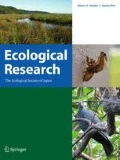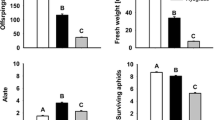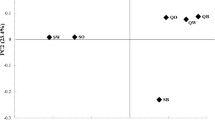Abstract
Although distinct host specialization is observed for the cotton-melon aphid (Aphis gossypii Glover) on cotton and cucurbit plants, it is still ambiguous whether the specialization is altered by experience on a novel host plant. Here the performance of cotton and cucurbit-specialized aphids, A. gossypii on novel host plants was studied by a host-selection test and by the life-table method. The two host-specialized aphids cannot survive and establish populations after reciprocal host transfers. They have ability to recognize the host plants on which they were reared, and escape behavior from novel hosts was observed. Interestingly, the cotton and cucurbit-specialized aphids survive and reproduce normally on hibiscus (Hibiscus syriacus), a main overwintering host plant, and host-fidelity of A. gossypii to cucurbit plants is altered by feeding and living experience on hibiscus, which confers the same capacity to use cotton and cucumber on to the cucurbit-specialized population, but host-fidelity to cotton is not altered and the fitness of the cotton specialized population to cucumber is still poorer. A. gossypii from hibiscus has a significant preference for cotton to cucumber in the host-selection process, and none stays on cucumber more than 20 h after transfer. The results presented imply that cucurbit-specialized aphids might not return to an overwintering host plant (hibiscus) in wild fields, so host conservatism to cucurbit plants is maintained. The potential of cucurbit-specialized aphids of A. gossypii to use cotton plants, intermediated by experience on hibiscus, suggests that the specialized host-plant performance of phytophagous insects is not wholly conservative.



Similar content being viewed by others
References
Blackman RL, Eastop VF (2000) Aphids on the world’s crops, an identification guide, 2nd edn. Wiley, Chichester
Caballera PP, Ramirez CC, Niemeyer HM (2001) Specialization pattern of the aphid Rhopalosiphum maidis is not modified by experience on a novel host. Entomol Exp Appl 100:43–52
Caillaud MC, Via S (2000) Specialized feeding behavior influences both ecological specialization and assortative mating in sympatric host races of pea aphids. Am Nat 6:606–621
De Barro PJ, Sherratt TN, David O, Maclean N (1995) An investigation of the differential performance of clones of the aphid Sitobion avenae on two host species. Oecologia 104:379–385
Delobel A, Delobel B (2006) Dietary specialization in European species groups of seed beetles (Coleoptera: Bruchidae: Bruchinae). Oecologia 149:428–443
Ding JH, Su JY (2002) Agricultural entomology. Chinese Agricultural Press, Beijing
Fox LR, Morrow PA (1981) Specialization: species property or local phenomenon? Science 211:887–893
Futuyma DJ, Moreno G (1988) The evolution of ecological specialization. Annu Rev Ecol Syst 19:207–233
Gorur G, Lomonaco C, Mackenzie A (2005) Phenotypic plasticity in host-plant specialization in Aphis fabae. Ecol Entomol 30:657–664
Guldemond JA (1990) Choice of host plant as a factor in reproductive isolation of the aphid genus Cryptomyzus (Homoptera, Aphididae). Ecol Entomol 15:43–51
Guldemond JA, Tigges WT, De Vrijer WF (1994) Host races of Aphis gossypii (Homoptera: Aphididae) on cucumber and chrysanthemum. Environ Entomol 23:1235–1240
Inaizumi M (1981) Life cycle of Aphis gossypii (Homoptera, Aphididae) with special reference to biotype differentiation on various host plants. Kontyû Tokyo 7:219–240
Jaenike J (1990) Host specialization in phytophagous insects. Annu Rev Ecol Syst 21:243–273
Janz N, Nyblom K, Nylin S (2001) Evolutionary dynamics of host-plant specialization: a case study of the tribe nymphalini. Evolution 55:783–796
Jermy T, Szentesi A (2003) Evolutionary aspects of host plant specialization––a study on bruchids (Coleoptera: Bruchidae). Oikos 101:196–204
Kergoat GJ, Silvain JF, Delobel A, Tuda M, Anton KW (2007) Defining the limits of taxonomic conservatism in host-plant use for phytophagous insects: molecular systematics and evolution of host-plant associations in the seed-beetle genus Bruchus Linnaeus (Coleoptera: Chrysomelidae: Bruchinae). Mol Phylogenet Evol 43:251–269
Komazaki S (1990) Variation in the hatch timing of the overwintering egg among populations of Aphis spiraecola Patch (Homoptera: Aphididae) collected from different host plants and localities in Japan. Appl Entomol Zool 25:27–34
Komazaki S (1998) Difference of egg diapause in two host races of the spirea aphid, Aphis spitsecola. Entomol Exp Appl 89:201–205
Kring JB (1959) The life cycles of the melon aphid, Aphis gossypii Glover, an example of facultative migration. Ann Entomol Soc Am 52:284–286
Liu XD, Zhai BP, Zhang XX (2003) Studies on the host biotypes and its cause of cotton aphid in Nanjing, China. Sci Agric Sin 36:54–58
Liu XD, Zhai BP, Zhang XX, Lu Y (2004) Differentiation in morphometrics and ecological adaptability of cotton and cucumber biotypes of the cotton aphid, Aphis gossypii. Acta Entomol Sin 47:768–773
Mackenzie A (1996) A trade-off for host plant utilization in the black bean aphid, Aphis fabae. Evolution 50:155–162
Meng L, Li BP (2001) Researches on biotypes of cotton aphid in Xinjian. Acta Gossypii Sinica 13:30–35
Morse GE, Farrell BD (2005) Ecological and evolutionary diversification of the seed beetle genus Stator (Coleoptera: Chrysomelidae: Bruchinae). Evolution 59:1315–1333
Muller FP (1980) Wirtspflanzen, egerationenfolge und reproductive isolation infraspezifischer formen von Acyrthosiphon pisum. Entomol Exp Appl 28:145–157
Nosil P (2002) Transition rates between specialization and generalization in phytophagous insects. Evolution 56:1701–1706
Poulin R, Krasnov BR, Shenbrot GI, Mouillot D, Khokhlova IS (2006) Evolution of host specificity in fleas: Is it directional and irreversible? Int J Parasitol 36:185–191
SAS Institute Inc (2001) JMP user’s guide, version 4. SAS Institute Inc., Cary
Sunnucks P, Driveer F, Brown WV, Carver M, Hales DF, Milne WM (1997) Biological and genetic characterization of morphologically similar Therioaphis trifolii (Hemiptera: Aphididae) with different host utilization. B Entomol Res 87:425–436
Thompson JN (1994) The coevolutionary process. University of Chicago Press, Chicago
Tuda M (2007) Applied evolutionary ecology of insects of the subfamily Bruchinae (Coleoptera: Chrysomelidae). Appl Entomol Zool 42:337–346
Tuda M, Chou LY, Niyomdham C, Buranapanichpan S, Tateishi Y (2005) Ecological factors associated with pest status in Callosobruchus (Coleoptera: Bruchidae): high host specificity of non-pests to Cajaninae (Fabaceae). J Stored Prod Res 41:31–45
Tuda M, Ronn J, Buranapanichpan S, Wasano N, Arnqvist G (2006) Evolutionary diversification of the bean beetle genus Callosobruchus (Coleoptera: Bruchidae): traits associated with stored-product pest status. Mol Ecol 15:3541–3551
Vargas RR, Troncoso AJ, Tapia DH, Olivares-Donoso R, Niemeyer HM (2005) Behavioral differences during host selection between alate virginoparae of generalist and tobacco-specialist Myzus persicae. Entomol Exp Appl 116:43–53
Via S (1991) Specialized host-plant performance of pea aphid clones is not altered by experience. Ecology 72:1420–1427
Ward SA, Leather SR, Pickup J, Harrington R (1998) Mortality during dispersal and the cost of host-specificity in parasites: how many aphids find hosts? J Anim Ecol 67:763–773
Wool D, Manheim O, Burstein M, Levi T (1994) Dynamics of re-migration of sexuparae to their primary hosts in the gall-forming Fordinae (Homopter: Aphidoidea: Pemphigidae). Eur J Entomol 91:103–108
Acknowledgments
This research was supported by the National Science Fund of China (grant no. 30571222). We thank for two anonymous reviewers for helpful comments and for improving the manuscript.
Author information
Authors and Affiliations
Corresponding author
About this article
Cite this article
Liu, X.D., Zhai, B.P. & Zhang, X.X. Specialized host-plant performance of the cotton aphid is altered by experience. Ecol Res 23, 919–925 (2008). https://doi.org/10.1007/s11284-007-0458-9
Received:
Accepted:
Published:
Issue Date:
DOI: https://doi.org/10.1007/s11284-007-0458-9




